Yves GARY Hits: 5246
Category: PILGRIM
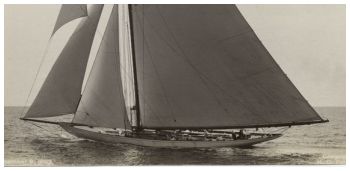 To organize the defense of the America's Cup in 1893, the Americans launched an unprecedented campaign: no less than four contenders are built! The New York Yacht Club asked to Nat Herreshoff to build two sailboats, Vigilant and Colonia. For their part, the Bostonians put two boats under construction, borrowed heavily from Dilemma, the first true "bulb keel" Nathanael G. Herreshoff designed by 1891.
To organize the defense of the America's Cup in 1893, the Americans launched an unprecedented campaign: no less than four contenders are built! The New York Yacht Club asked to Nat Herreshoff to build two sailboats, Vigilant and Colonia. For their part, the Bostonians put two boats under construction, borrowed heavily from Dilemma, the first true "bulb keel" Nathanael G. Herreshoff designed by 1891.
The architectural firm of Stewart & Binney, successor of Edward Burgess, author of three previous winners, designs Pilgrim, a pure "bulb keel" in steel with a centreboard on the front.
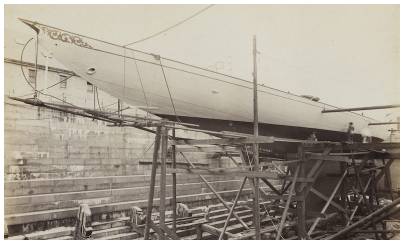 Pilgrim was an immense steel fin-keel: her body was canoe shaped, a beautiful example of early light displacement, and the hull was fitted with a keel formed by a veil at the end of which was fixed a lead bulb of ballast shaped like a cigar. The rudder was separated from the keel.
Pilgrim was an immense steel fin-keel: her body was canoe shaped, a beautiful example of early light displacement, and the hull was fitted with a keel formed by a veil at the end of which was fixed a lead bulb of ballast shaped like a cigar. The rudder was separated from the keel.
"These two Boston boats show the possibilities of the fin-keel design. It is the form which gives the maximum of sail carrying power to the minimum of displacement,” was the assessment from a delighted George Stewart. And early tests on the water proved that in light winds, these sloops easily reached 13 to 14 knots of boatspeed, an impressive achievement.
But Steward also noted, “All of these experiments, while adding greatly to the potential speed of the boat, also increase the possibility of failure.”
Regrettably, the facts were going to prove him prescient. On September 7th, 9th and 11th, 1893, Defender selection trials were sailed of Sandy Hook. 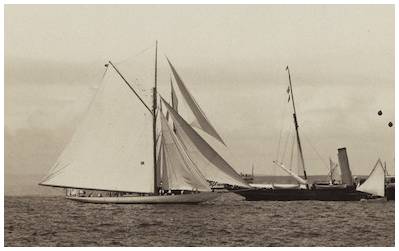 More reliable, Vigilant dominated all three times over the Boston boats which suffered various incidents. They succeeded in finishing only in the second race when Jubilee earned second place and Pilgrim finished third.
More reliable, Vigilant dominated all three times over the Boston boats which suffered various incidents. They succeeded in finishing only in the second race when Jubilee earned second place and Pilgrim finished third.
Pilgrim proved to be fast on some points of sailing, but her canoe-shaped body, of small displacement, combined with her deep and flexible fin that buckled when she was on the wind, made her unreliable for competitive racing. Though she sailed well on a straight line, Pilgrim did not always mind her helm, due to the length of her fin.
After the America's Cup trials, Pilgrim was sold to L. G. Burnham, Esquire, of Boston, who had her converted into a steam yacht. The fin was removed and a keel and skeg installed, thus changing her draft to 6.7 feet. In addition, a low level cabin was added to the after part of the vessel. After serving as Mr. Burnam's personal yacht, the Pilgrim was listed in 1907 under the ownership of Boston Floating Hospital. 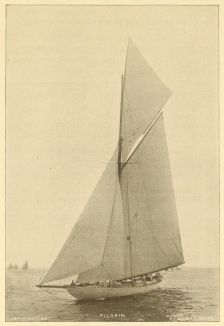 The next two years, she was owned by Wendell H. Wyman, apparently as a private yacht. During 1910 and 1911, Pilgrim was listed as a fishing vessel, with Boston continuing as her home-port.
The next two years, she was owned by Wendell H. Wyman, apparently as a private yacht. During 1910 and 1911, Pilgrim was listed as a fishing vessel, with Boston continuing as her home-port.
Two years later, Beaufort became home for the Pilgrim. It is not known what circumstances occurred to cause this classic sailing vessel to be in Carteret County; however, in 1913 she was owned by Hugh C. Jones of Beaufort and was being used for menhaden fishing.
The vessel was modified to include an open fish hole, crows nest for fish spotting, a gaff to raise and lower the bail net and striker boat, and a set of davits was installed to hold the purse boats. Through all these changes, Pilgrim continued to retain a lot of her original characteristics, with two masts, rigging, sails, and the same classic hull design. Undoubtedly, she made a striking appearance for all to see and definitely was easily identifiable from the rest of the menhaden fleet.
Pilgrim continued in the menhaden fishing trade under the ownership of Beaufort Fish Scrap & Oil Company from 1916 through 1926, with a break of several years to serve Uncle Sam during World War I. The vessel was acquired from her owner by the U. S. Navy and commissioned on July 18, 1917. She was fitted out for patrol duty, identified as SP (Section Patrol) 1204, and assigned to the 5th Naval District, where she operated from Pamlico Sound through Onslow Bay. 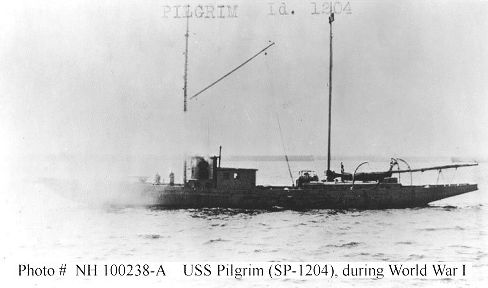 Her speed was listed as 6.9 knots. She was armed with 2 one-pound guns and carried a complement of twenty-seven men. The vessel was decommissioned by the U. S. Navy on January 7, 1919, and returned to Beaufort Fish Scrap & Oil Company.
Her speed was listed as 6.9 knots. She was armed with 2 one-pound guns and carried a complement of twenty-seven men. The vessel was decommissioned by the U. S. Navy on January 7, 1919, and returned to Beaufort Fish Scrap & Oil Company.
Newport Fisheries Company owned the Pilgrim from 1927 to 1933. The late William G. (Captain Glady) Oglesby, Morehead City, was engineer and later captain of the vessel during part of this time period. Other local men who served as captain of the Pilgrim during her menhaden fishing career included Harry Parkin, Bob Lewis, Jack Parkin, and John Pake, who was probably her last captain.
The captains of the menhaden vessels operating out of Beaufort - Morehead City strived to catch as many fish as possible each time they went out and at the end of the fishing season wanted their boat to be recognized as "high boat". There were many boats for the Pilgrim to compete against, including the W. M. Webb, Colonel, Captain, Elizabeth, Chas. S. Wallace III, W. A. McIntosh, Deutchland, The Boys, Leland Mills, and W. A. Mace. Though it is not known if the Pilgrim was "high boat" during one or more seasons, she undoubtedly served her different captains, crew, and owners well, providing gainful employment to a number of people in our county through many years of service.
Mr. Van Wye, who at the time owned property on the west end of Harkers Island at Harkers Point, had her towed from Beaufort to his property where she became a breakwater. Cement was poured into the vessel to keep her from moving. Ms. Martha Salter, Ms. Audrey Parker, and David Yeomans remember, as children growing up on Harkers Island, the good times they had playing on the deck of the Pilgrim and jumping off her to go for a swim.
The passage of time and adverse weather conditions, coupled with a daily bath of salt spray, has taken a great toll on the Pilgrim. But, even after all these many years, a bare skeleton of her hull still remains at Harkers Point today, continuing to remind us of a once stately and classic boat that indeed had a very unique and rewarding career.

- Pilgrim (SP 1204) - NavSource Online
- PILGRIM, JUBILEE, JUAN K, STEWART & BINNEY, JOHN PAINE, AMERICA' CUP 1893 - Chevalier Taglang
- Pilgrim et Jubilee, les ancêtres des Wally - Voiles et Voiliers
- PILGRIM AND JUBILEE: INNOVATION 100 YEARS BEFORE THE AMERICA'S CUP CLASS
- LAUNCH OF THE PILGRIM - STEWART and amp - BINNEY CUP DEFENDER ON THE WATER. - Article - NYTimes.com :
